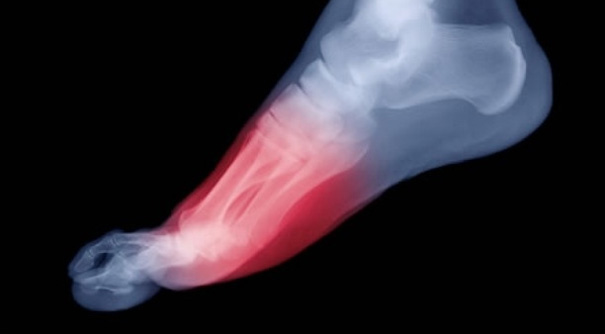Forefoot pain is a common complaint in new forefoot runners. In most cases, the forefoot pain is often interdigital neuroma, also known as Morton’s neuroma, where one of the nerves in the forefoot gets compressed or becomes entrapped due to the swelling of surrounding collateral ligaments. More specifically, degenerative changes to parts of the nerve takes place, too.
The most common site of pain occurs just under the 3rd and 4th toes (i.e. on top of the 3rd and 4th metatarsal head). The pain is often a burning sensation, cramping, tingling, and numbness in the forefoot and the toes (Hockenbury, 1999). Luckily, this nagging condition can be resolved and by informing you on how this particular type of forefoot pain is caused.

Forefoot Pain from Forefoot Running
There are 3 causes of forefoot pain in inexperienced forefoot runners.
1. Pushing-Off Too Hard With Your Toes – Many forefoot runners who transition from heel strike running — a running style where the toes are used to propel the body into flight, retain this habit when they are forefoot running. But in forefoot running, we lean with the torso, removing the need to push-off with the toes. So, avoid pushing with your toes.
2. Lifting Your Toes Too Much – Forefoot runners who transition from heel strike running also have the habit of lifting the toes before the foot strikes the ground. Lifting your toes and forefoot at touchdown makes it easier to heel strike. Since we are landing on our forefoot first in forefoot running, there’s no need to lift it up. Relax your toes, and let your forefoot fall to the ground.
3. Narrow Running Shoes – This one’s a no-brainer. We now know how crippling narrow running shoes are to the feet. Running shoes with a narrow toe box causes bunions, metatarsal weakness, and nerve damage, like in Morton’s neuroma, because the forefoot gets compressed. In forefoot running, the toes need to expand for balance and shock absorption; wearing narrow running shoes will only exacerbate forefoot compression, causing pain.
Try Going Barefoot More Often
One of the reasons why I love doing some of my training runs barefoot is that it forces me to push less with my toes (simply because it hurts), and most importantly, my feet have more freedom to spread. Amazingly, there are now running shoes that mimic the feel of being barefoot, and this too, will help with your forefoot pain.
More Great Articles From Run Forefoot:
Why Nerve Damage is Common in Older Runners
How You Should Swing Your Arms When Running
How Impact Is Different In Forefoot Running vs Heel Strike Running
References:
Hockenbury, RT. Forefoot problems in athletes. Med Sci Spor Exerc, 1999;31(7);S448
Bretta Riches
BSc Neurobiology; MSc Biomechanics candidate, ultra minimalist runner & founder of RunForefoot. I was a heel striker, always injured. I was inspired by the great Tirunesh Dibaba to try forefoot running. Now, I'm injury free. This is why I launched Run Forefoot, to advocate the health & performance benefits of forefoot running and to raise awareness on the dangers of heel striking, because the world needs to know.
Latest posts by Bretta Riches (see all)
- Heel Lifts Increase Injury in Runners - 16/04/2024
- Are Minimalist Shoes Good for Seniors? YES! - 14/04/2024
- BIG Deals On Running Gear And More! - 09/04/2024
